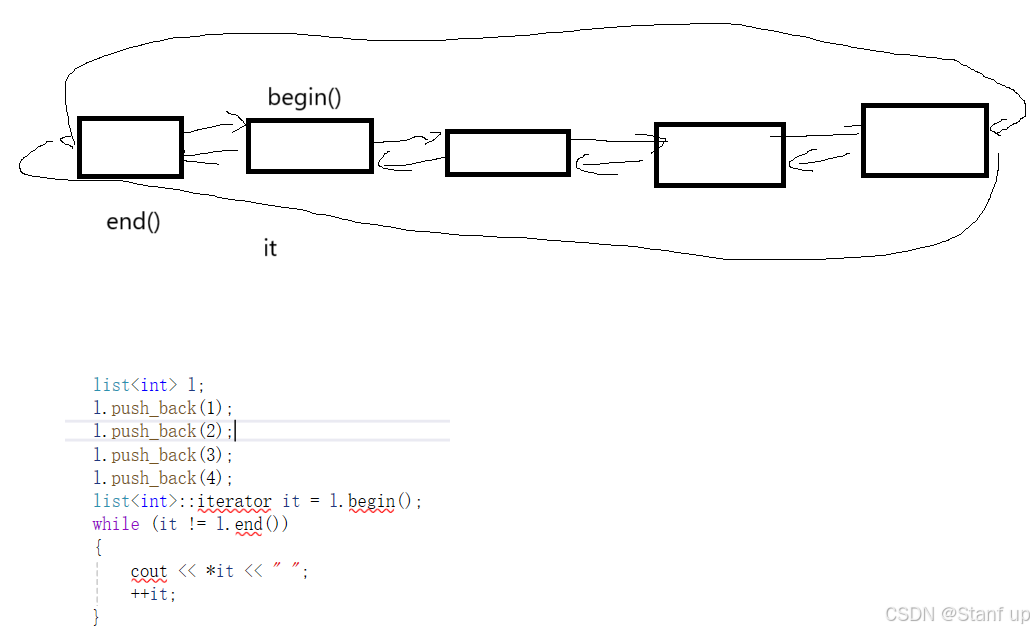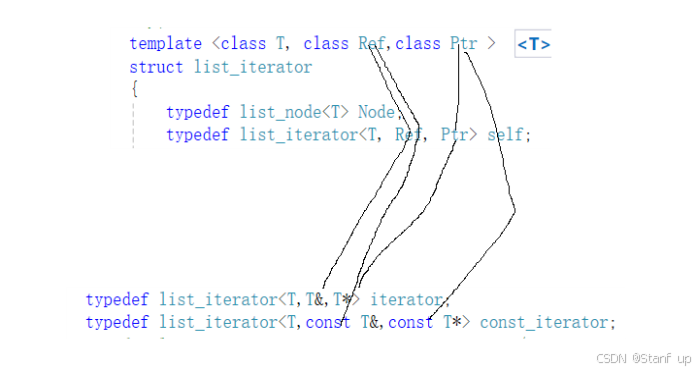营销型企业网站源码seo网站关键词排名软件
目录
一、构造和扩容机制
二、普通迭代器
三、const迭代器
四、tip
有了前面vetcor的基础呢,我们在学习和使用list上就更加的方便快捷,浅显易懂了,所以相似的部分我就不做过多的言语阐述了,在使用方面呢,大家可以学习我之前看的c++网站,和vector和string的使用都是差不多的,重点要放在list的迭代器部分
一、构造和扩容机制
template <class T>class list{typedef list_node<T> Node;public:void empty_init(){_head = new Node;_head->_next = _head;_head->_prev = _head;}list(){empty_init();}void push_back(const T&val){Node* tail = _head->_prev;Node* newnode = new Node(val);tail->_next = newnode;newnode->_prev = tail;newnode->_next = _head;_head->_prev = newnode;}private:Node* _head;空初始化的时候我们也需要构造,所以缺省值我们给一个匿名对象进行初始化,这个我们在vector的模拟实现里面有重点说到
template <class T>
struct list_node
{T _data;list_node<T>* _next;list_node<T>* _prev;list_node(const T& data=T()):_data(data),_next(nullptr),_prev(nullptr){}
};二、普通迭代器
void listtest1()
{list<int> l;l.push_back(1);l.push_back(2);l.push_back(3);l.push_back(4);list<int>::iterator it = l.begin();while (it != l.end()){cout << *it << " ";++it;}
}这里我们还没有实现迭代器

这是一个带头双向循环链表,我们结合迭代器来看,由于它是一个结构体,我们解引用并不能得到它的数据,++it也不能得到向后走,!=也判断不了end(),因为里面存在着数据和前后指针,这时候我们就要运算符重载和封装这里
这里我们为什么不用class来写那个list_node 呢因为你写class就要把它定义成友元,而这里我们是要把这个类的权限全部开放所以我们定义成struct
template <class T>
struct list_iterator
{typedef list_node<T> Node;typedef list_iterator<T> self;Node* _node;list_iterator(Node* node):_node(node){ }self& operator++(){_node = _node->_next;return *this;}T& operator*(){return _node->_data;}bool operator!=(const self&s){return _node != s._node;}};我们来阐述一下这里的行为,我们封装了一个Node,实例化了一个对象,写出构造函数,++让里面的指针++返回这个Node的下一个位置的引用,下面也是类似,就是指针完成不了的事情我们通过间接的方式来让类完成
typedef list_iterator<T> iterator;
iterator begin()
{return _head->_next;
}
iterator end()
{return _head;
}这里begin和end返回指着可以的原因是单参数的构造支持隐式类型的转换
这里重要的就是封装,封装屏蔽了底层差异和实现细节,提供统一访问修改遍历方式
这算是一种模拟指针的行为
我们简化了这里的接口,list_iterator封装了链表节点的指针,通过重载一系列运算符,用户可以像指针一样遍历链表,而不必关心节点如何连接
这里我们先封装一个简单的
先把其他的架子实现出来
首先是删除
iterator erase(iterator pos)
{Node* cur = pos._node;Node* prev = cur->_prev;Node* next = cur->_next;delete cur;prev->_next = next;next->_prev = prev;return iterator(next);
}删除这里会涉及迭代器失效的问题,有关于迭代器失效可以看一下我vector里面有详细的写,总而言之就是这里pos的位置删除了,而你的迭代器没有进行及时的更新,所以我们这里让迭代器指向下一个位置
iterator insert(iterator pos, const T& val)
{Node* cur = pos._node;Node* newnode = new Node(val);Node* prev = cur->_prev;prev->_next = newnode;newnode->_prev = prev;newnode->_next = cur;cur->_prev = newnode;return iterator(newnode);
}一般来说这里的insert不会发生迭代器失效,但是库里面有写,而且可以和上面统一一下
这样子我们的头插头删尾插尾删就可以复用这里的
void push_back(const T&val)
{insert(end(), val);}
void push_front(const T& val)
{insert(begin(), val);
}
void pop_back(const T& val)
{erase(end(), val);
}
void pop_front(const T& val)
{erase(begin(), val);
}void clear()
{iterator it = begin();while (it != end()){it = erase(it);}
}这个时候我们上面的删除迭代器就派上用场了,删除完我们返回下一个迭代器位置就行了
我们的析构就可以套用这个clear了
~list(){clear();delete _head;_head = nullptr;}接下来我们来实现一下拷贝构造
list(list<T>& l)
{empty_init();for (auto e : l){push_back(e);}
}这里不用const原因是因为e不是const对象,等下我们实现了const迭代器就可以实现了
再让我们实现一下赋值
首先是传统写法
//lt3=lt1//list<T>& operator=(list<T>& l)//{// if (this != &l)// {// clear();// for (auto e : lt)// {// push_back(e);// }// }//}现代写法
void swap(list<T>& l)
{std::swap(_head, l._head);
}
list<T>& operator=(list<T>& l)
{swap(l);return *this;
}交换头节点的指针就可以了
为了不让有的人去获取这个链表的size时时间复杂度是o(n),我们添加一个szie在private那里,在初始化那里给上0,insert那里++,erase那里--就好了
void swap(list<T>& l)
{std::swap(_head, l._head);std::swap(_size, l._size);
}我们再来看一下后置++
self operator++(int)
{self tmp(*this);_node = _node->_next;return tmp;
}self operator--(int)
{self tmp(*this);_node = _node->_prev;return tmp;
}bool operator==(const self& s)
{return _node == s._node;
}迭代器是不需要实现析构函数的,因为它不需要把那个节点给带走,你可以访问节点,但是不能带走不属于它的节点
为了支持自定义类型的实例化访问我们还需要实现->
T* operator->()
{return &_node->_data;
}
三、const迭代器
template <class T>
struct list_const_iterator
{typedef list_node<T> Node;typedef list_const_iterator<T> self;Node* _node;list_const_iterator(Node* node):_node(node){}self& operator++(){_node = _node->_next;return *this;}self operator++(int){self tmp(*this);_node = _node->_next;return tmp;}self& operator--(){_node = _node->_prev;return *this;}self operator--(int){self tmp(*this);_node = _node->_prev;return tmp;}const T& operator*(){return _node->_data;}const T* operator->(){return &_node->_data;}bool operator!=(const self& s){return _node != s._node;}bool operator==(const self& s){return _node == s._node;}};typedef list_const_iterator<T> const_iterator;
const_iterator begin() const
{return _head->_next;
}
const_iterator end() const
{return _head;
}void print_list(const list<int>& l)
{list<int>::const_iterator it = l.begin();while (it != l.end()){cout << *it << " ";++it;}
}这个const_iterator不是const iterator的类型,指针本身可以被修改,但是指针指向的内容不能被修改
那我们这里写成两个能不能复用一下搞成一个呢,我们看一下库里面的
同一个类模板,实例化参数不同,就是完全不同的类型
template <class T, class Ref,class Ptr >struct list_iterator{typedef list_node<T> Node;typedef list_iterator<T, Ref, Ptr> self;Node* _node;list_iterator(Node* node):_node(node){}self& operator++(){_node = _node->_next;return *this;}self operator++(int){self tmp(*this);_node = _node->_next;return tmp;}self& operator--(){_node = _node->_prev;return *this;}self operator--(int){self tmp(*this);_node = _node->_prev;return tmp;}Ref & operator*(){return _node->_data;}Ptr* operator->(){return &_node->_data;}bool operator!=(const self& s){return _node != s._node;}bool operator==(const self& s){return _node == s._node;}};typedef list_iterator<T,T&,T*> iterator;
typedef list_iterator<T,const T&,const T*> const_iterator;
我们定义了两个类,我们也不知道这是什么类,留给后面来定义,只知道Ref相当于&类型的,Ptr代表*类型的,
Ref & operator*()
{return _node->_data;
}
Ptr* operator->()
{return &_node->_data;
}比如说当我们实例化int的时候,普通对象先传给T&,再把T&传给Ref,Ref就可以实例化出来这个类进行使用,定义了一个const对象就实例化出来一个const的类出来,看似是一个类,在当你实例化普通和const对象的时候其实是两个类
四、tip
template<class T>
void print_list(const list<T>& l)
{list<T>::const_iterator it = l.begin();while (it != l.end()){cout << *it << " ";++it;}for (auto e : l){cout << e << " ";}cout << endl;
}
void listtest3()
{list<int> l;l.push_back(1);l.push_back(2);l.push_back(3);l.push_back(4);print_list(l);
}这段代码我们会发现编译不通过
template<typename T>
void print_list(const list<T>& l)
{typename list<T>::const_iterator it = l.begin();while (it != l.end()){cout << *it << " ";++it;}for (auto e : l){cout << e << " ";}cout << endl;
}改成这样就可以了,因为你list里面是模板,模板又没有实例化,编译器不敢去类里面找,去里面找也没有实例化,其次是你const_iterator是静态成员变量还是内嵌类型不知道,编译器分不清,前面加一个typename就是告诉编译器这里是一个类型,等list<t>实例化,再去实例化类型里面去找
那我们这个print如果想针对所有容器怎么办
template<typename Container>void print_container(const Container& l){typename Container::const_iterator it = l.begin();while (it != l.end()){cout << *it << " ";++it;}for (auto e : l){cout << e << " ";}cout << endl;}void listtest3(){vector<string> v;v.push_back("11111111111");v.push_back("11111111111");v.push_back("11111111111");v.push_back("11111111111");print_container(v);}}和上面是一样的玩法,把实例化这个类型传给了container
模板实现了泛型编程,把我们本来干的活交给了编译器
好了list就到这里结束了,接下来是栈和队列,写的不好的地方欢迎大家指出
